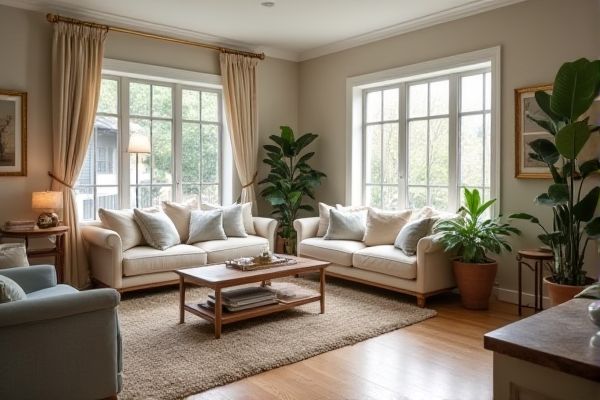
Closed stringer staircases feature side panels that cover the ends of the treads and risers, providing a sleek, modern look with enhanced safety by minimizing gaps. Open stringer stairs reveal the edges of each step, creating a more open and airy feel that suits contemporary designs; explore the rest of this article to determine which option best fits your space and style preferences.
Table of Comparison
| Feature | Closed Stringer | Open Stringer |
|---|---|---|
| Definition | Stringer encloses the stair treads on both sides. | Stringer exposes the treads' edges, creating an open look. |
| Appearance | Traditional, solid, and enclosed staircase design. | Modern, airy, and visually lighter design. |
| Structural Support | Provides strong lateral support and runs full length of stairs. | Supports only outer edges, may require additional reinforcement. |
| Installation Complexity | Generally simpler due to enclosed sides. | More complex; precise measurements required for alignment. |
| Cost | Typically lower due to simpler fabrication. | Usually higher; custom cuts and finishes increase cost. |
| Safety | Enclosed sides reduce risk of tripping or falling off edges. | Open sides might pose higher risk without adequate railing. |
| Common Uses | Residential homes, traditional staircases. | Modern homes, commercial spaces emphasizing design. |
Introduction to Stair Stringers
Closed stringers, also known as housed stringers, feature recessed notches that support each stair tread, creating a streamlined and concealed side profile ideal for modern interior designs. Open stringers, or cut stringers, have a sawtooth profile that exposes the edges of the treads, offering a more traditional or decorative aesthetic often used in rustic or industrial staircases. Selecting between closed and open stringers impacts structural support, visual style, and installation complexity in stair construction.
What is a Closed Stringer?
A closed stringer is a type of staircase design where the treads are fully enclosed on both sides by the stringer, providing a clean and finished appearance. Unlike open stringer stairs, the closed stringer conceals the edges of the treads, enhancing safety by eliminating gaps. Closed stringers are commonly used in residential and commercial settings for their structural support and modern aesthetic appeal.
What is an Open Stringer?
An open stringer is a staircase design where the treads and risers are supported externally on either side, leaving the stringer edges exposed and often cut in a decorative pattern. This type of stringer allows for a more visually open and airy appearance, making it ideal for modern or minimalist interiors. Your choice between open and closed stringers will impact both the aesthetic and structural characteristics of your staircase.
Structural Differences Between Closed and Open Stringers
Closed stringers feature a fully enclosed side profile, offering enhanced lateral stability and distributing loads more evenly across the staircase structure. Open stringers display a cut-out profile, exposing the treads' edges and allowing for greater visual openness but requiring precise engineering to maintain structural integrity. The critical difference lies in load distribution and support mechanisms, with closed stringers providing inherent reinforcement while open stringers depend on additional brackets or supports to ensure safety and durability.
Aesthetic Comparison: Closed vs Open Stringer
Closed stringers create a sleek, modern aesthetic by concealing the stair treads and risers within the stringer structure, resulting in a clean and minimalist look. Open stringers expose the stair treads, adding architectural interest and a sense of openness that can make spaces feel larger and more inviting. Your design choice will depend on whether you prefer a contemporary, streamlined appearance or a more traditional, airy feel in your staircase.
Installation Process: Step-by-Step Guide
Closed stringer stairs feature a side panel that conceals the treads and risers, requiring precise measurement and cutting for each step to fit seamlessly within the framework. Open stringer stairs have visible treads supported by notched stringers, allowing easier access for adjusting tread placement during installation. Your choice affects the installation complexity, with closed stringers demanding meticulous alignment and secure fastening, while open stringers offer greater flexibility and a quicker assembly process.
Cost Analysis: Open Stringer vs Closed Stringer
Open stringer staircases generally incur lower material and labor costs due to their simpler design and easier installation process. Closed stringers, featuring enclosed sides, often require more wood and detailed craftsmanship, increasing both material expenses and labor hours. Budget-conscious projects typically favor open stringers for cost efficiency, while closed stringers are selected when aesthetics and structural integrity justify the higher investment.
Durability and Maintenance Considerations
Closed stringer staircases offer enhanced durability due to their enclosed support design, protecting structural elements from damage and wear. Open stringers expose the edges of treads and risers, making maintenance more frequent as dust and debris accumulate more easily. Your choice between closed and open stringers will impact long-term upkeep, with closed stringers generally requiring less maintenance over time.
Best Applications for Each Stringer Type
Closed stringers are ideal for indoor staircases where aesthetics and safety are priorities, such as residential homes and commercial buildings, offering a smooth, streamlined appearance with concealed treads. Open stringers suit industrial or modern design spaces, providing an open, airy feel that enhances natural light flow, making them perfect for lofts, offices, and galleries. Your choice depends on whether you prioritize a clean, enclosed look with added support or a visually open structure that emphasizes space and design elements.
Choosing the Right Stringer for Your Staircase
Closed stringers provide a sleek, modern look by concealing the stair treads and risers within the stringer, making them ideal for minimalist interior designs. Open stringers reveal the stair structure, enhancing the visual appeal with exposed treads and creating a more spacious and airy feel suitable for contemporary and industrial styles. Selecting the right stringer depends on aesthetic preference, structural requirements, and the desired balance between openness and design complexity in your staircase project.
 homyna.com
homyna.com